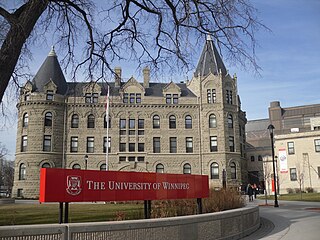
Winnipeg is the capital and largest city of the province of Manitoba in Canada. It is centred on the confluence of the Red and Assiniboine rivers, near the longitudinal centre of North America. As of 2021, Winnipeg had a city population of 749,607 and a metropolitan population of 834,678, making it the sixth-largest city, and eighth-largest metropolitan area in Canada.
The Winnipeg City Council is the governing body of the city of Winnipeg, Manitoba, Canada. The Council is seated in the Council Building of Winnipeg City Hall.

The Winnipeg Metropolitan Region is a metropolitan area in the Canadian province of Manitoba located in the Red River Valley in the southeast portion of the province of Manitoba, Canada. It contains the provincial capital of Winnipeg and 17 surrounding rural municipalities, cities, and towns.
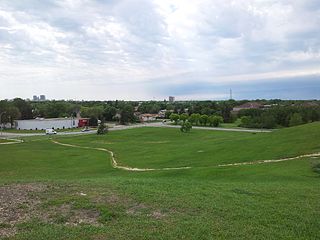
East Kildonan is a primarily residential community in northeast Winnipeg, Manitoba, Canada. Commonly known by its initials EK, the suburb has a population of approximately 35,800 as of the 2016 Census.

Tuxedo is a residential suburb of Winnipeg, Manitoba. Prior to 1972, the community was incorporated as the Town of Tuxedo. Today, it is the wealthiest area of Winnipeg, with the highest property values.
Old Kildonan is the northernmost city ward of Winnipeg, Manitoba. Before the City of Winnipeg Act of 1972, it was an independent unincorporated municipality called the Municipality of Old Kildonan; prior to that, from 1914, it was a subdivision of the Rural Municipality of Kildonan.
St. Vital is a ward and neighbourhood of Winnipeg, Manitoba, Canada.

The amalgamation of Winnipeg, Manitoba, was the municipal incorporation of the old City of Winnipeg, 11 surrounding municipalities, and the Metropolitan Corporation of Greater Winnipeg (Metro) into a one Unified City of Winnipeg, or Unicity.
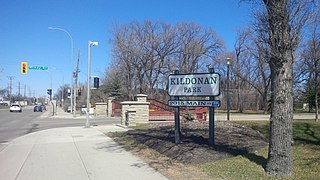
Kildonan Park is a park in the West Kildonan area of northern Winnipeg, Manitoba, Canada.

St. James-Assiniboia is a major community area in Winnipeg, Manitoba, Canada. As it encapsulates most of the city ward of St. James, which includes the major St. James Street, the area itself is often simply referred to "St. James."

Winnipeg Transit is the public transit agency, and the bus-service provider, of the City of Winnipeg, Manitoba. Established 139 years ago, it is owned by the city government and currently employs nearly 1,600 people—including approximately 1,100 bus drivers.

Transport in Winnipeg involves various transportation systems, including both private and public services, and modes of transport in the capital city of Manitoba.
Wildwood Park is a suburban, planned community in Winnipeg that has a central green space and no front roads, with communal walkways, playgrounds, and parks.
Route 52 is a major north-south arterial route in Winnipeg, Manitoba, Canada. It comprises all of Main Street, Queen Elizabeth Way, and St. Mary's Road.

The history of Winnipeg comprises its initial population by Aboriginal peoples through its settlement by Europeans to the present day. The first forts were built on the future site of Winnipeg in the 1700s, followed by the Selkirk Settlement in 1812. Winnipeg was incorporated as a city in 1873 and experienced dramatic growth in the late 19th and early 20th centuries. Following the end of World War I, the city's importance as a commercial centre in Western Canada began to wane. Winnipeg and its suburbs experienced significant population growth after 1945, and the current City of Winnipeg was created by the unicity amalgamation in 1972.
Winnipeg, Manitoba, is subdivided in different ways for different purposes. The suburbs and neighbourhoods of Winnipeg take their names from former administrative districts, parishes, and geographic features.
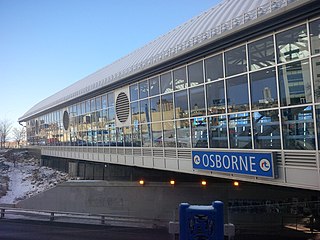
Winnipeg RT is a bus rapid transit system of Winnipeg Transit in Winnipeg, Manitoba, Canada, currently consisting of the Southwest Transitway. Future expansions are in the planning stages, consisting of an Eastern Corridor connecting downtown to Transcona and a West-North Corridor connecting St. James with Downtown and West Kildonan.
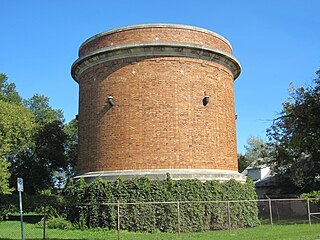
The Greater Winnipeg Water District Aqueduct supplies the city of Winnipeg, Manitoba with water from Shoal Lake in the Kenora District of Ontario. It was put in service in 1919 and cost nearly CDN $16 million. It has a capacity of 85 million Imperial gallons per day and extends approximately 96 miles (154 km) from an intake structures on Shoal Lake to the Deacon Reservoir on the east side of the city. Water flows by gravity from the lake, since the aqueduct drops about 300 feet (91 m) over its length. The Greater Winnipeg Water District Railway was built for construction and maintenance of the aqueduct. The capacity was planned for a city of one million inhabitants; peak water usage by the city was in 1988 and the capacity of the aqueduct has never been entirely used. An additional 12 miles (19 km) branch was completed in 1960.
Broadway is a street in the city of Winnipeg, Manitoba, Canada. It is one of the city's oldest and most historic routes and forms the Trans-Canada Highway route through the city's downtown.












